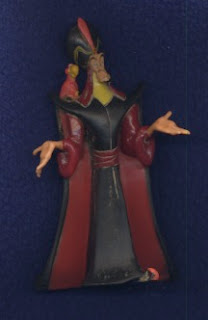This is my collage, from the scans my classmates posted on their blogs. I've decided to call it "Sneak Attack!!"

Monday, January 31, 2011
Exercise in Photoshop from class
This is the collage I made in class on Thursday, and finished just now. I bet you can't find the three things I inserted! Actually I bet you can; that's the point of putting them in there...
Monday, January 24, 2011
Artist blog: Charles Cohen
Charles Cohens series Buff consists of images of porn with the people photoshopped out. The people are often recognizable both as human and by their sex from the outline created in their absence and the poses are frequently so sexual that it is hard to misconstrue them, even without the aid of contextual clues in the background. These images focus on the backgrounds, which are the only source of color and also more of a foreground than the cut-out people are. This series relies on the recognition of this type of image by the audience as well as the connotations the type carries with it to inform the work. The series’ meaning is derived from the audience’s preconceived ideas interacting with the image presented.
That being said, I found this particular image to be the most interesting of the series. First, the negative space part of the image is not clearly human; to me it looked more like a weird octopus-like creature. Upon further inspection, it becomes more human in appearance, but still remains slightly abstract. This adds to the theme of dehumanization, which is apparent in the complete removal of humans from the image. The dehumanization acts in much the same way as it does in porn without the people cut out of it; the porn industry removes the individual from sex, both in terms of the subject of the image and the viewer. The removal of the pornographic image removes the only thing that people want the images for; they certainly don’t look it up to check out other people’s home décor.
The essentializing of the porn into its most basic is not singularly associated with this topic; it has the same dehumanizing effect in the way the Western world views the Eastern world and vice versa. In my Southeast Asian philosophy and religion class today we talked about how when the British colonized India they re the many different reduced the many religions of India into a singular set of beliefs which were dubbed Hinduism. This reducing of things into their most basic qualities has been going on for centuries and hasn’t changed with the advent of digital technology. Cohen flips this reductionist idea on its head by removing the only essential part of the picture.
Another interesting aspect of this image is the use of femininity. Every image in the series of a single person is a woman; there are no solo guys. I will admit that this could just be because the artist is male, but it still warrants mentioning. The female figure is particularly prone to being dehumanized in many art forms (visual and otherwise) as well as in the media and until recently through the lack of legal rights; Women gained suffrage less than one hundred years ago. As far as the issue of homosexuality is concerned in this particular image, the dehumanization of this type of image represents a broader kind of inhumanity associated with homosexuality by its opponents. The controversy surrounding the level of humanity present in people of this persuasion is still highly charged, as I’m sure everyone is aware, but to put it in context, it was only in 1973 that homosexuality was officially removed from the Diagnostic and Statistical Manual of Mental Disorders (DSM). (see link)
One major strength I see in Cohen’s series is his diversity in original images. The idea that no matter the starting point, the end result will be the same is a powerful one. Several of the images include a body only partially represented and cut off the edge of the picture plane, while others include multiple bodies framed entirely within the image. The images come from both sexes (with the exception of the lack of single men) and are set both indoors and outdoors with various objects surrounding the negative space.
On the whole I find Cohen’s Buff series to be both culturally enlightening as well as philosophically relevant to the question of where pornographic images fit into society and where the line is drawn to define an image as crude.
Sources:
http://www.promulgator.com/
University of California, Davis
Wednesday, January 19, 2011
The Youtube Experience
I was required to make this blog for my Intro to Digital Media Art class. When I looked at the pages of last semester's student blogs for the course, I was a bit astonished. Most of them were titles with the course number and (at least at first glance) appeared to strictly focus on digital art in a traditional sense. The phrase traditional sense strikes me as a little irrelavent to this particular aspect of life though, so I've decided that my blog, from the start, will be much different from the cookie-cutter ones I saw. First of all, I've let the design of the page stray fairly far from the topic, as I'm sure you can see (and I'm sure it will change periodically). Secondly, I want to describe for you my experiences with this class and more generally with digital media, so expect to see references to anything from Harry Potter to Southeast Asian philosophy to Austin's Emma. I will find a way to connect it all.
For my first entry, I'll stick to what we discussed in class on Tuesday. My professor showed us part of a video about the anthropology of Youtube. Over the course of the discussion, a thought occured to me; I have gotten so much of my identity either directly through the internet, or through routes similar in nature to it. My vocabulary naturally includes verbs like google, tweet, and download as well as acronyms like LOL & FML and symbols like less-than-three. A great example of this sort of viral communication becoming ingrained in people and becoming essential to their personalities comes from a personal anecdote. Last summer, while hanging out with a group of friends, one of them insisted that I listen to a song she had on her iPod. After hearing it, I was entranced; The Midnight Beast quickly became my new favorite band and I have since liked them on facebook and seen all of their Youtube videos. The interesting part comes when i mention that these three guys are from the UK. They started out with nothing more than a single video for their parody of Ke$ha's "Tik Tok," which they posted on December 9, 2009; by Christmas of the same year, the video was featured on Youtube's main page, and it now boasts an impressive 9,961,858 views.
My friend, it turns out, had heard the song from one of her friends, who discovered it via one of her friends, and like so the voyage of this tiny 3 minute 44 second long video made it's way across the Pond and through the iPod speakers into my ears. My love of The Midnight Beast followed suit when i clicked the links to their other videos. Their not-so-subtle humor and catchy coreography has become fairly important to the way I behave on a daily basis. I have even begun to use the word "ninja" as an adjective in daily conversations as a way of saying "really good," thanks in part to their video Ninjas, even though they maintain its noun-ness in the song. The band currently has 245,491 likes on facebook, not counting the numerous non-official pages in their honor. Their newest video was uploaded to Youtube 14 hours ago and already has 22,539 views.
The digital landscape is running over into the real world in many ways, and necessarily in a bad way. It changes us forever - there is no taking it back once it's out there - but change is a double-edged sword; there are upsides and downsides chasing eachother all over the place and it's not our job to command them, only to take them for what they are and run with it.
For my first entry, I'll stick to what we discussed in class on Tuesday. My professor showed us part of a video about the anthropology of Youtube. Over the course of the discussion, a thought occured to me; I have gotten so much of my identity either directly through the internet, or through routes similar in nature to it. My vocabulary naturally includes verbs like google, tweet, and download as well as acronyms like LOL & FML and symbols like less-than-three. A great example of this sort of viral communication becoming ingrained in people and becoming essential to their personalities comes from a personal anecdote. Last summer, while hanging out with a group of friends, one of them insisted that I listen to a song she had on her iPod. After hearing it, I was entranced; The Midnight Beast quickly became my new favorite band and I have since liked them on facebook and seen all of their Youtube videos. The interesting part comes when i mention that these three guys are from the UK. They started out with nothing more than a single video for their parody of Ke$ha's "Tik Tok," which they posted on December 9, 2009; by Christmas of the same year, the video was featured on Youtube's main page, and it now boasts an impressive 9,961,858 views.
My friend, it turns out, had heard the song from one of her friends, who discovered it via one of her friends, and like so the voyage of this tiny 3 minute 44 second long video made it's way across the Pond and through the iPod speakers into my ears. My love of The Midnight Beast followed suit when i clicked the links to their other videos. Their not-so-subtle humor and catchy coreography has become fairly important to the way I behave on a daily basis. I have even begun to use the word "ninja" as an adjective in daily conversations as a way of saying "really good," thanks in part to their video Ninjas, even though they maintain its noun-ness in the song. The band currently has 245,491 likes on facebook, not counting the numerous non-official pages in their honor. Their newest video was uploaded to Youtube 14 hours ago and already has 22,539 views.
The digital landscape is running over into the real world in many ways, and necessarily in a bad way. It changes us forever - there is no taking it back once it's out there - but change is a double-edged sword; there are upsides and downsides chasing eachother all over the place and it's not our job to command them, only to take them for what they are and run with it.
Subscribe to:
Posts (Atom)












